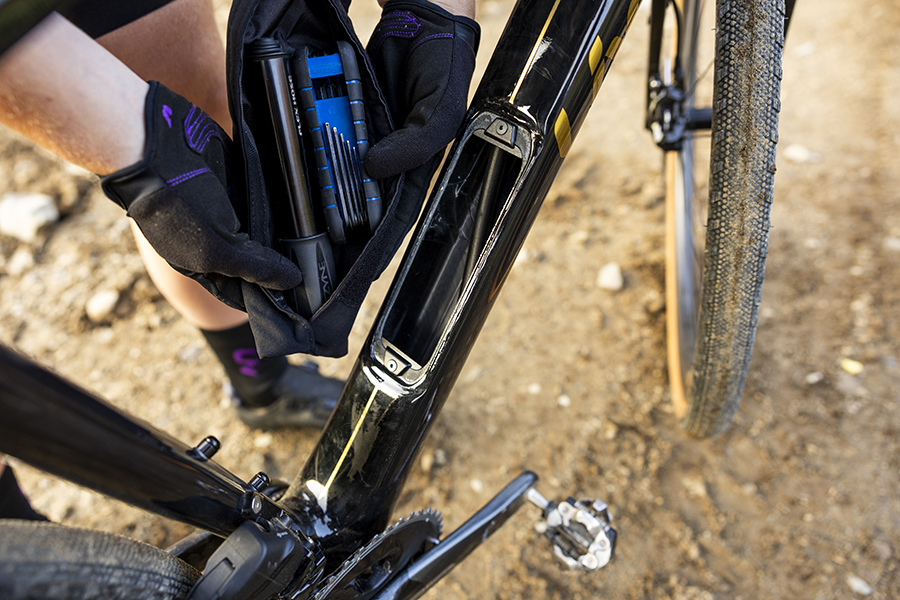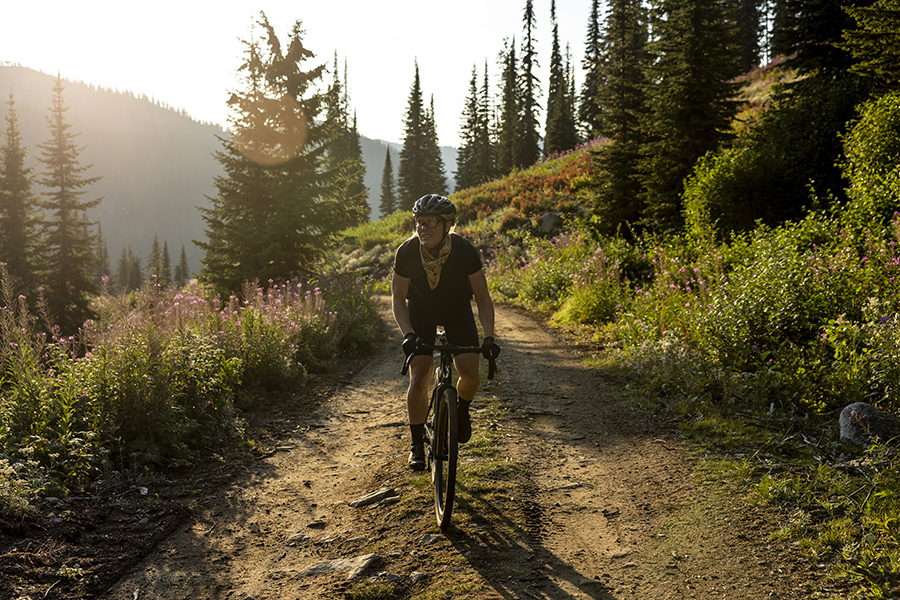Geared Up Sneak Peek: Liv Devote Advanced Pro
When the representative from Liv emailed me asking if I wanted a surprise, I said yes. Once she started asking for my measurements, I started to get the clue that it was a bicycle.
She sent it to a local bike shop, who told me they were keeping the bike in the back room because it was under embargo. It wasn’t until I got home and let the representative know I had successfully received the bike that I was given all the information. So this review feels a bit like a blind date, but one that went really well.
With only a week to test the Liv Devote Advanced Pro — that week being press week for our magazine (the final crunch week that ends in sending the magazine to the printer and me sleeping through most of the weekend, drooling into my store-brand Apple Jacks and watching Bob’s Burgers reruns), and the bike unable to be ridden or transported in places where people may see it — the pressure was on for me to find any free hours available to take this bike on the most fun, varied rides I could think of. Luckily, I live in Montana.
I’ve put about 200 miles on this bike this week, not enough for a typical review but enough for a “first thoughts” rundown of what I liked and disliked about the bike (and to be clear, I really like it). Let’s start with the positives. Bicycles have historically been designed around European-descent male body geometries. While a lot has happened with bicycle geometry over the past hundred-plus years with the thousands of bicycle builders to grace our planet with their artistry and alchemy, some aspects remain either unchangeable, such as crank lengths outside the four typical lengths, and in an industry still dominated by European-descended male bodies as bike designers, some aspects are simply overlooked. While there are plenty of valid arguments for and against “women specific” bike designs and bike companies, I really do think Liv is “doing it right.” Each bike of theirs that I’ve tested feels like a custom-built bicycle by an increasingly astute builder.
This newest launch of the Devote line just had its geometry re-tweaked to fit most female bodies with regards to leg and torso lengths, hip and shoulder widths, and weight and power distribution, while taking into account riding styles and performance. With the poetically-named handlebar (Contact SLR XR D-Fuse) and integrated Contact AeroLight stem, I really felt like I could ride this bike all day — which is good because I had to test this bike in long chunks and twice I found myself, err, “turned around” on the back of a mountain, hence the singletrack as I navigated myself back to civilization. Notably, though, the numbness I typically get in my toes after riding more than 15-20 miles was minimal to nonexistent, and my hands were also in great shape even at the end of my longest rides. I attest this not only to the geometry but also to the carbon everything (more or less) which is the build on the Advanced Pro but not on the other models, so keep that in mind. I don’t know if this is the first time I’ve ever ridden carbon wheels, but it’s the first time I’ve ridden them and thought, “worth it.”

Anyway, back to geometry. From the previous Devote line (which, full disclosure, I did not test), this one has a longer top tube, longer reach, shorter head tube, and shorter stack with the goal of making this 2024 model an “aggressive, performance-oriented bike.” I personally think that’s largely in the mind of the rider, as I’ve seen a rider on a full suspension mountain bike with a raked-out fork bail on a grassy knoll and I’ve seen someone else bunny hop a park bench on a clunker. But I can say that I took this bike on some flat straightaway dirt paths, winding mountain doubletrack, and even some singletrack, and while I wished for slightly different components (I’ll get into that in a moment) in some scenarios, the bike felt like it wanted to go fast and for the most part, we did. If you need to dial the bike in further, each Devote in the 2024 lineup comes with flip chip dropouts. This allows a rider to adjust their bike to their riding style — either a faster, more agile ride with 45mm tires in the “short” position or a more steady, stable ride with clearance for 53mm tires in the “long” position.
Beyond the fancy carbon bits and the absolutely perfect geometry (as a person with a long inseam and short torso, I can’t emphasize enough how magical it feels for a bike to fit this well out of the box), there is another nice feature new to this lineup: the down tube has a little storage compartment with a water-resistant bag to carry gear and protect it from vibrating around. This compartment is under the water bottle cage, which makes it a little awkward for the snacks I stashed in there, but it’s a perfect spot for an emergency snack, or if you’re more reasonable you can hide your small multitool or very small pump or air cartridges in there. According to Liv, this compartment is designed around their own tools and products, so random multitools might not fit as designed; additionally, they suggest inserting items toward the head tube and sliding them down to the bottom bracket to get the most space usage. I felt nervous trying to force my tool kit into this orifice (in a bike I do not own and would have to return soon and is made of carbon), but those concerns might not plague a rider who purchases this bike for themselves or who purchases a Devote 0, Devote 1, or Devote 2, all of which come with an aluminum frame and carbon fork.

The frame and fork also have a number of smart mounts which should make it easier to avoid stashing your gummies in the secret compartment. There are top tube bolts for a small bag, bolts for three bottle cages (down tube, seat tube, and under the down tube), and two-bolt braze-ons (bolts not included) on both fork arms, plus fender mount options front and rear (again, bolts not included — instead, there are rubber stoppers in place for a very streamline look).
My critiques of this bike have more to do with components than the bike itself. The Sram Force eTap AXS shifting, for instance, is … weird. To spare you the five minutes on the side of the road that I spent trying to figure it out: the left flipper shifts the rear derailer into an easier gear; the right flipper shifts the rear derailer into a harder gear. If you are looking at the bike and thinking, But this has a double? Where is the front shifter? You are more reasonable than the engineers at Sram, in my opinion. To shift the front, you take a deep breath, erase your brain of everything you thought you knew about bikes, and tap both flippers at the same time. If you find yourself in a position, as I did, where the derailer isn’t shifting enough and the chain doesn’t move to the larger chain ring, there’s not much to do with electronic shifting besides shift down and up again until something engages.
Now, I put up with a lot of stuff with the bike industry over the past 20-ish years, but this may be a step too far for me. At this point, every bike I own has a different method of shifting, which is frustrating enough. They all follow the same ethos, though. This feels like someone designed themselves into a corner betting too many chips on 1x being the end-all be-all of drive trains. I’m very thankful to see a double on a modern, fancy gravel bike, but is this really the cost we must pay?
Supposedly, if you download the Sram AXS app you have the ability to make adjustments to how and when things shift, and in that way they’ve put a lot of thought into modern shifting. I’m no retro grouch, and think innovation is important, but I do wonder sometimes about the application of such inventions. Some people will love this, or at least won’t mind it, but it’s worth pointing out before you purchase a $6,500 bike and spend an afternoon not being able to get it to do the most basic of functions.
The seatpost is also too fancy for my liking, but it’s a give and take. This bike has been rapidly test ridden out the door with the Liv Approach SL factory saddle, each ride I’ve taken it on has had roughly 20 miles of consistent climbing up gravel roads, and I have felt totally comfortable the entire time. This is probably in large part to the Contact SLR D-Fuse seatpost. I do like that it’s got numbers listed on it so I can figure out and remember my saddle height. I don’t like that it has a shim to make up for the D-shaped seatpost and that the shim seems to get stuck (because, to their credit, it will fit a standard round seatpost, either 30.9mm or 27.2mm, shims included), or that it’s a carbon post and when I’ve adjusted it trailside I haven’t had a torque wrench (not many bike travelers bring their torque set with them) so I’ve been petrified of over-tightening. When I brought this up to Liv, their representative noted that the rubber cover takes some finesse to master the technique of “pressing it in” (finesse being notably one of my shortcomings), but that once you get that gesture down it is much easier, and that the rubber is helpful to prevent the seatpost slipping. The Devote Advanced 1 comes with a dropper post, which is a fantastic idea if you are planning on taking this bike on the aggressive rides it’s been designed for with the longer reach — there were a couple moments when the trail got very steep and I wished I had the ability to drop the saddle to more confidently shift my weight to navigate down. Luckily, if you love everything about the Liv Advanced Pro except the post, you can easily install a dropper.

The other component I would probably upgrade are the Cadex AR tubeless 700x40c tires. For a lot of regions they are probably fine but they seem to be trying to do too much, have a fast rolling surface while still have enough traction on dirt. For me, this made them not feel great on anything and I’d much rather have traction when going into a tight turn on a descent than be able to roll fast on pavement. I took this bike on pavement, gravel, dirt road, grass, mud, and rocky singletrack and I kept it rubber side down the whole time so the tires are clearly not terrible. However, there were definitely times when I had to have faith in my own handling skills, which I don’t like to do, and a nicer set of tires with knobbed side walls would give me that peace of mind. Worth noting, the Devote Advanced 1 also comes with more aggressive (Maxxis Rambler 700x45c) tires, in addition to the aforementioned dropper post.
All in all, this bike is incredibly fancy, incredibly fun, and perhaps overbuilt, depending who’s interested. Did I feel a bit like I was on a midlife crisis bike when I surprised myself by how light it is when I picked it up with more force than necessary? Yes. But am I in the middle of my life and likely facing some sort of crisis that may be properly ignored with something shiny? Yes. The Devote Advanced Pro model is the fanciest of the fancy, and maybe the best of the best. It rides great, it’s comfortable for the longest days in the saddle, and it fits like a custom bike right out of the box. If you don’t need or want the fanciest of the fancy, I get it. The other models have the same great geometry and also come with great build options for their price points. But then again, maybe this is your year to treat yourself to some beautiful opulence?
Liv Devote Advanced Pro
Best uses: gravel, light touring, gravel racing, mixed surface
Price: $6,500 as built
Frame: Advanced-grade composite, 12x142mm thru-axle, flat mount disc, flip chip – dropout, integrated down tube storage, integrated cable routing
Fork: Advanced SL-grade composite, full-composite OverDrive steerer, stainless steel bearings, 12mm thru-axle, flat mount disc
Weight: 18.6 lbs. without pedals
Available sizes: XS, S, M, L
Size tested: M
Front derailer: SRAM Force eTap AXS Wide
Rear derailer: SRAM Force eTap AXS
Cassette: SRAM Force, 12-speed, 10×36
Crankset: SRAM Force D2 DUB, 30/43
Crank length: XS: 165mm, S: 170mm, M: 172.5mm, L: 172.5mm
Brakes: SRAM Force eTap AXS hydraulic, SRAM CenterLine rotors
[F]160mm, [R]160mm
Rims: Giant CXR 1 Carbon Disc WheelSystem, [F] 35mm, [R] 35mm, tubeless ready
Tires: CADEX AR, 700x40c, tubeless
Extras: 53mm max tire size in long flip chip position, 45mm max tire size in short flip chip position, tubeless prepared, ISC clamp, integrated down tube storage bag

